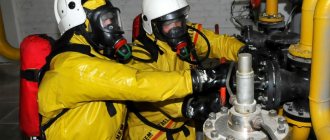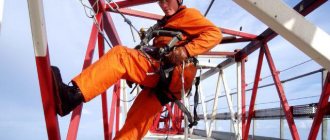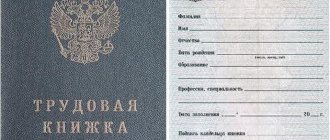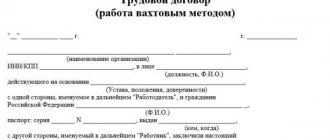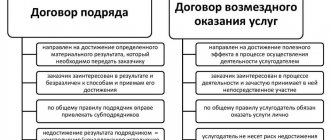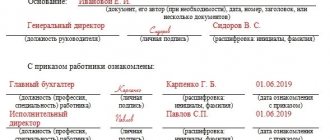There are many types of work that is dangerous from the point of view of the possibility of a fire, carried out both in buildings, structures, on the territory of mining, procurement, industrial, agricultural enterprises, construction sites; and in buildings for various public purposes, residential buildings during reconstruction, planned, emergency repairs, replacement of sections of engineering systems/communications, roofs.
These include the following types of events:
- Cutting metal structures, rolled metal with power tools, because this is accompanied by the scattering of hot drops and sparks with high energy sufficient to ignite organic substances/materials, while spark arresters have not yet been invented for such situations.
- Heating of parts/products, mounting structures using open fire during assembly/installation.
- Any types of gas-electric welding work, as well as cutting structures, products, scrap metal using this type of equipment.
- Using equipment for cutting scrap metal, building and installation structures using flammable gases - propane, acetylene, liquids - gasoline, kerosene.
- Soldering of various metals.
- Heating of bitumen and other mastics/compositions used for construction/repair of roofs, waterproofing of building structures, utility pipelines/systems.
If similar types/types of hazardous work are carried out in specially designated premises for these purposes, places - welding stations, workshops, areas of workshops/productions, equipped in accordance with the norms/rules of industrial safety with primary means for fighting fire - carbon dioxide, powder, air-foam fire extinguishers, boxes with sand, fire-resistant fabric/felt, properly equipped PCs, as well as on the territory, in buildings, structures of private households, construction sites; then they do not require any permitting documents.
If any type of such work is carried out in temporary places, with the exception of the above-mentioned situations, then in accordance with the PPR that determines the fire safety regime on the territory of Russia, the head of the enterprise/organization, or an official appointed by him, is responsible for the fire safety of the building, workshop, site , the premises are issued with an approval order (OA) for hot work (OR).
Types of hot work
The list of hot work (HW) is quite wide. It includes not only processes in which an open flame of fire is used, but also those in which fire is only an auxiliary factor. Let's list all the types:
- gas welding, electric welding, as well as metal cutting using these technologies;
- metal soldering;
- cutting metal products and structures using power tools, during which a large number of sparks are released, which cause the fire of flammable materials;
- heating of structures or equipment during their installation/dismantling;
- heating of bitumen or bitumen mastics, which are used in construction for waterproofing structures, pipelines and other utility networks;
- cutting metal products, structures where gases and liquids are used (the latter - gasoline or kerosene).
It should be noted that a work order for performing hot work is not always necessary. If these operations are carried out in specially designated premises or fenced areas, then fire operations are carried out in them constantly without the requirement of permits. Such areas are equipped in accordance with fire safety rules, that is, with primary fire extinguishing means: fire extinguishers, sand, water and accessories (shovels, felt mats, bucket).
In other cases, a work permit must be issued. It is signed either by the manager, or the chief engineer, or the employee who is responsible for the fire safety of the facility. At the same time, the document indicates for how long it is issued (usually for one shift), where fire activities will be carried out, and who will carry them out. If work is not completed in one shift, then the permit is extended, which is noted in a special paragraph of the work order. If the work contractor has changed, this is also indicated in the permit.
Attention! The issuance of a permit for hot work must be reported to the site fire department, which must allocate its employees for control. Here an entry is made in a special journal where and when these processes will be carried out.
What is this document for?
The design of the outfit has preventive and legal significance. Despite the measures taken, an emergency situation is still possible. According to the labor protection rules, it is necessary to conduct an investigation at the legal level and then a clear answer will be received to the question: does the work permit require a permit for welding work.
This document has legal significance, and it is drawn up in the interests of those persons who are responsible for the correct performance of dangerous work. One of the arguments in their favor when analyzing their actions is “forewarned is forearmed.” Having access to welding work will indicate that they have fulfilled their duties.
The preventive value of observing this formality is invaluable. When a person must perform such dangerous actions every day due to his profession, his attention may become dull. Receiving an outfit mobilizes his attention, forces him to exercise reasonable caution and can save his health, and maybe even his life. Not to mention the fact that property may be significantly damaged and, as the culprit, he will have to pay significant sums of money.
Work permit
The form of the permit for hot work is shown in the photo below. This is a document that gives permission to carry out work associated with an increased fire danger. It is issued only to highly qualified workers who have undergone special training (profile technical), received a certificate (diploma or certificate), and have also completed training in the fire-technical minimum.
The permit approval, as mentioned above, is approved either by an official of the facility or by the person responsible for food safety at the facility. This relates to the question of who issues the permit for hot work at the enterprise. As for the control of ongoing operations related to fire hazards, there are a large number of employees: the workshop manager, the shift supervisor, in which this type of activity is carried out, who are responsible for the fire safety of the enterprise.
The permit is issued on a standard form; it is legalized by the fire regulations of 2012 (Appendix No. 4). There is nothing complicated in the preparation of the document. Let's look at how to do this correctly.
How is an admission order issued?
Drawing up a work order for hot work is the final stage. Before this you need:
- Think over a plan for upcoming work, which should be carried out only during daylight hours. It is taken into account that after all events are completed, the person responsible for fire safety will inspect the venue to make sure that everything is completed, there are no fires, and the place itself has been cleaned.
- The hot work site is being prepared: the area is cleared of combustible and flammable materials; if necessary, protective enclosing structures are installed in the form of screens made of non-combustible materials.
- Technological processes are stopped in places where operational procedures are carried out where fire hazardous substances are used. The tanks in which flammable liquids are stored are hermetically sealed.
- The areas are provided with fire extinguishing equipment.
- If the OR is carried out by subcontractors, then the employee responsible for industrial safety at the site checks the documents of the workers sent to carry out the OR.
An example of filling out a permit for hot work
The preparation is complete, you can proceed to registration. The procedure for issuing a work permit for hot work is to enter into the document the necessary data that relates to the workers, the place and time of the work. Here are a few main points:
- to whom it is issued;
- what type of OR (heating, welding, etc.);
- where it is carried out indicating the exact location;
- composition of performers (number of people by name);
- time: beginning and end.
The permit is signed by the employee issuing it and receiving it. As well as senior staff responsible for preparing the OR site, and heads of relevant facility services. Approved by the head of the enterprise, his deputy or chief engineer.
Learn more about the officials involved in issuing permission to conduct hot work.
- If the enterprise consists of several workshops, then the issuance is carried out by the head of the workshop where the fire activities will be carried out. This can be done by the chief mechanic, power engineer, technologist or their deputies.
- The person responsible for preparing the event area is the head of the unit where this type of event will be held.
- The person responsible for carrying out the OR is the shop engineer, shift supervisor, foreman, and foreman.
- The observers include different employees, but usually the employee responsible for the safety of the premises, employees of repair services, the shop and shift supervisor.
If the enterprise has an organized fire department, then their representatives must participate in this event.
The permit form for performing hot work contains additional items and tables. They are filled out if the ORs were not completed during one shift. The main table numbered “11”, into which new employees are entered. They will carry out OR in place of those who left their shift. In paragraph “10” enter the name and position of the managerial employee with whom the replacement of employees was agreed upon.
And one more question - how long is the hot work permit kept? Its shelf life is 1 month. Usually it is collected in folders that lie in the safe or desk of the head of the workshop where the operational reviews were carried out.
Liability and fines
For violation of the regulations of the Federal legislation regarding the organization and conduct of fire events, officials will be held administratively liable.
Fines will be imposed on the organization and its leadership. In the event that an emergency situation arises due to a safety violation that results in death or injury, those responsible will be prosecuted under the Criminal Code.
Safe hot work is presented in this video.
Work without a permit
As mentioned above, a work permit for hot work is not required if it is carried out in specially designated areas equipped in accordance with all fire safety rules. But there are situations when urgent repairs are required due to the failure of technological equipment or utility networks. That is, an emergency or extreme situation has come into force.
In such cases , emergency operations can be carried out even at night, with the caveat that the emergency area must be well lit.
But an emergency situation does not protect those responsible from violating industrial safety requirements. That is, all processes must be carried out strictly in accordance with fire safety rules. This primarily concerns the preparation of the site where OR will be carried out and equipping them with fire extinguishing equipment. If violations are discovered during events with open fire, and they lead to damage to the material and technical base or to the death of people, then you will have to answer for all of this.
Current restrictions
When carrying out fire and explosion hazardous operations, a number of restrictions apply:
- when performing hot work, clothing should not be contaminated with flammable liquids;
- Employees with appropriate qualification certificates must be allowed to perform tasks;
- It is prohibited to work in closed spaces filled with explosive vapors;
- The welding machine and other equipment cannot be powered directly from the distribution network.
There is also a requirement for carrying and angling cylinders. All actions must be performed in full accordance with safety precautions.
Options for permit orders
The hot work permit form is a standard form. But some enterprises still use another document, which is approved by the Ministry of Economy in rules POTRO-14000-005-98. This is a shortened form of completion, which indicates only the location, the list of operations being carried out, to whom the permit was issued and the deadlines for completion.
You won't find anyone here to do the work. There is no information about the qualifications of the workers, about the training provided, about the employees who perform control, etc. The shortened version is less informative than the form from PPR-2012. And although the choice remains with the management of the enterprise, fire inspectors recommend using the work permit as a more capacious document in terms of semantic load.
conclusions
Occupational safety is an important factor in production; if a manager cares about the safety of his employees and the legal operation of the enterprise, then all standards must be observed.
To conduct hot work, a permit must be issued, without which the manager will be fined, and in the event of an incident, they will also be prosecuted.
Employees performing activities under the permit must have the necessary education and undergo full safety training.
Organization procedure
It should be noted that employees who will carry out OR must take their duties responsibly. And here it should be noted that the same welders are required to strictly follow fire safety rules, which include:
- undergoing training with an entry in a special journal and affixing signatures;
- checking the tools, equipment and devices used to ensure they are in good technical condition;
- checking the workplace for compliance with industrial safety rules;
- obtaining clean personal protective equipment.
After the end of the activities, the site, for example, must be cleaned by the same welders. And already within 2-3 hours, the person responsible for the fire safety of the facility will monitor the location of the emergency operation to ensure that there are no causes associated with the emergence of fires.
So, the permit is an important document. It is on its basis that hot work can be carried out. This is a permit confirming that the site is ready, and the work will be carried out by highly qualified workers who have access to carry out this type of event.
Video:
Recommendations for getting started
It is strongly recommended to begin fire-hazardous work exclusively during the daytime (light) hours, since during this period (the exception is force majeure and accidents) and with the direct participation of specialists with a special level of training and permits (various certificates, certificates, certificates, diplomas) ), confirming professionalism.
A work plan must be formed and approved by previously authorized specialists or heads of structural units; specialized equipment must be installed and prepared in explosive areas, thereby increasing the level of safety of the facility, turning off the power supply to devices and installations that may increase the risk of injury to humans.
Without exception, all specialists who are directly related to the work must undergo targeted training and successfully pass it, and receive individual fire protection equipment. The tools that need to be worked with are checked, and the workplace is prepared.
Important! You can begin work only after safety guarantees have been provided.
Air monitoring
Hot work related to high-risk work is permitted to begin only if there are no explosive or flammable substances in the air environment. Their presence and concentration must be determined by a special device (maximum permissible concentrations are prescribed in the Sanitary Standards). Measurements are carried out at equal intervals in communications, devices or places where work is taking place, as well as in a dangerous area.
If the content of hazardous substances inside the apparatus, pipeline, etc., or in a hazardous area exceeds the level, work must be stopped immediately. Their resumption is possible only after the causes of gas pollution have been identified and eliminated and the normal parameters of the air zone have been completely restored.
During work involving the use of fire, workshop personnel are obliged to take measures to exclude the slightest possibility of fire and explosive substances entering the air environment. It is also prohibited to open devices and hatches, unload, drain or reload oil-containing products, load them through open hatches and other actions that could cause a fire.
The work permit for performing hot work is signed by the person responsible for it, but only after acceptance of the prepared equipment and the place where the work will be performed from the person responsible for this work, and under normal air conditions.
